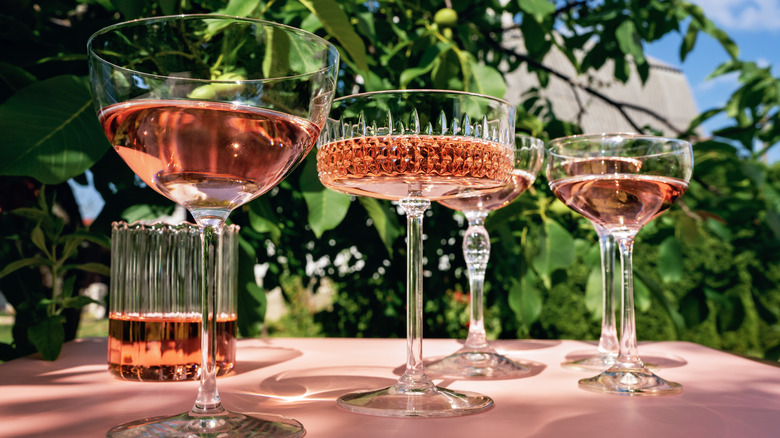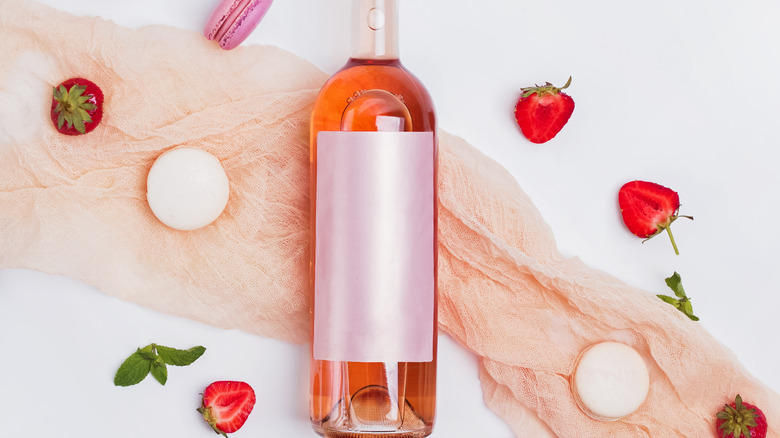Is Blush Wine The Same As Rosé?
Once upon a time, rosé wines had a terrible reputation as sweet drinks reserved for our dear old grandmas. But a few years ago, thanks to the availability of superior rosés from around the world, these refreshing wines are better understood, and the mainstream has embraced them. However, it is true that not all pink wines are created equal, and there is a big difference between a well-crafted rosé and a cheap grocery store "blush." Turns out that all rosés are blushes, but not all blushes are rosés — it all depends on how and from what grapes the wines are made.
Rosés are produced by the skin contact method, which means leaving the grape skins in the pressed juice for enough time to give it some color. The juice is then fermented, and the wine is made through the traditional winemaking process. Blush wines can also be made this way but, more often, they are a blend of ready made red and white wines and manufactured in big batches, which allows them to be cheaper. But there are other differences that you need to consider when choosing either one of these wine styles.
How are rosé wines made and how do they taste?
Rosés have a long history, especially in France, where the wines are said to achieve their highest expression — after all, the word rosé is French for pink. They are often made using the saignée method, which means bleeding out a portion of red wine juice from the fermentation tank and then continuing with the winemaking process. However, they are more commonly made using the skin contact method. Thus, rosés come in different styles and can be made from any red grape, from pinot noir to cabernet sauvignon, merlot, malbec, and sangiovese. In Provence, the most iconic region for French rosés, the most common grapes are syrah, grenache, cinsault, mourvèdre, and carignan.
Most good quality rosés will be dry with pleasant fruit notes. Depending on the grape varietal — or varietals — used, the flavor profiles and colors of rosés will vary. Thicker skinned grapes like cabernet sauvignon and malbec tend to produce darker rosés that are more full bodied and have stronger flavors of red plum, hibiscus tea, and blackberries.
Lighter rosés are more floral and fresh, closer to white wines with nice minerality and hints of berries, peaches, and sweet citrus. It's important to note that, while the color will influence the flavor, it does not determine the level of sweetness. Rosés are food-friendly and will pair with all kinds of unconventional options, from salads to seafood, roast chicken, and things from the grill.
How are blush wines different from rosés?
Unlike rosés, blush wines don't have deep roots in history. They were created — apparently by accident — in California in the 1970s when the winemaker at Sutter Home rescued a batch of not fully fermented zinfandel wine, bottling at a lighter color and higher sugar content. The resulting "White Zinfandel" went on to catch fire in the 1980s among newer wine drinkers. Most wines in this category are labeled "blush" or "pink" as opposed to rosé and are usually mass-made in the United States by big name brands, marketed as an approachable and easy-drinking option that's sweeter and much less expensive than a carefully made rosé.
They are made from red grape varietals, especially zinfandel and merlot. Their flavors range from off-dry to semi-sweet, so they can be enjoyed with fruits and desserts or mixed with soda to cut down the sweetness or to make a wine punch or sangria, such as this refreshing strawberry spritzer.


